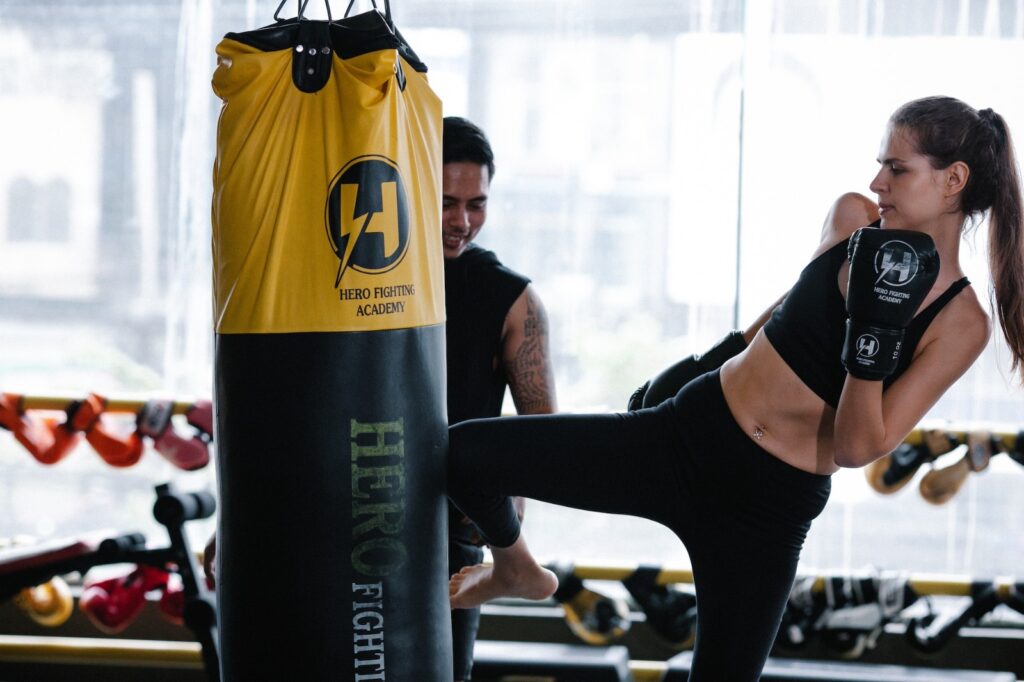Table of Contents
Welcome to the battleground of the hottest debate in the world of punching bags: What to Fill Punching Bags With?
It’s a question that has sparked passionate arguments, fueled intense discussions, and left fighters and trainers divided. Should it be sand, fabric, synthetic fibers, or perhaps something entirely unexpected? The battle lines are drawn, and everyone has their champion in this ultimate showdown of bag fillings.
In this article, we’ll explore the contenders, weigh the merits and demerits, and dive into the science and art behind each option. So grab your gloves, step into the ring, and let’s settle this debate once and for all, discovering the perfect filling that will unleash the warrior within you!
Common Filling Materials for Punching Bags

Every choice has its own unique character, just like different fighters in the ring. So, let’s dive right in and see what these fillings have to offer!
Sand
Here we go, sand – the classic filling material that has been a staple in the boxing world for ages. Why is it so popular, you ask?
Well, sand offers exceptional resistance and stability. When you throw a punch into a sand-filled bag, it fights back with an unyielding spirit. It’s like having an opponent who refuses to budge, pushing you to unleash your true power.
The benefits of sand-filled bags go beyond resistance. Sand offers excellent weight distribution, allowing the bag to maintain its shape and balance during intense workouts. It absorbs and dissipates the impact, making your punches feel solid and satisfying.
However, there are a couple of potential drawbacks to consider. Over time, the sand may settle at the bottom of the bag, leading to an uneven distribution.
This can cause the bag to feel lumpy or unbalanced, like trying to hit a bumpy road.
Additionally, sand-filled bags tend to be heavier, which may limit their portability and require more effort to move around. But hey, if you’re up for the challenge, sand-filled bags can take your training to the next level!
Fabric
Who knew that something as humble as the fabric could find its place inside a punching bag? Well, the fabric is a versatile filling material that offers its own set of advantages. You can use textile rags, old clothes, or towels to fill your bag, and it’s a fantastic way to repurpose those worn-out garments.
The beauty of fabric lies in its impact on bag density and weight. Depending on how much fabric you stuff in, you can adjust the firmness and resistance of the bag to suit your preferences. It’s like a customizable training experience – you’re in control!
But, as with everything, there are trade-offs. Fabric-filled bags tend to be lighter than their sand-filled counterparts.
While this makes them more portable, it may also affect their stability and durability. They might not offer the same unyielding resistance as sand-filled bags, but they still pack a punch.
Synthetic fibers
Ah, the adoption of synthetic fibers – a modern twist on bag fillings. These materials, such as polyester or nylon, provide an alternative to traditional options.
Synthetic fibers are known for their lightweight nature and consistent texture, making them a popular choice among fighters who value consistency.
The benefits of using synthetic fibers include their resistance to settling, which means you won’t have to worry about your bag becoming uneven over time.
These fibers also offer a more uniform weight distribution, allowing for a balanced and predictable training experience.
However, it’s important to note that synthetic fiber-filled bags might not have the same firmness or density as sand or fabric-filled bags.
They can be softer and less rigid, so if you prefer a bag with more resistance, you might want to explore other options.
Other materials
When searching ‘what do you fill punching bags with’ there are also a few wildcard entries worth mentioning. Some fighters get creative and use alternative materials like rice, shredded paper, or even water.
While these options may offer unique sensations or experimental training experiences, they often come with their own set of challenges.
Rice-filled bags can be prone to molding, shredded paper may compact too quickly, and water-filled bags can be messy and unpredictable. But hey, if you’re feeling adventurous, give them a shot and see what surprises they bring!
Factors to Consider When Choosing Filling Material

Training goals
Different filling materials can have a significant impact on the intensity and resistance of your punching bag.
Are you aiming to improve your endurance, enhance your strength, or sharpen your speed and agility? Each material can cater to specific training objectives.
For example, if you’re seeking a high-intensity, endurance-building workout, sand-filled bags might be your go-to option. Their dense and unyielding nature will push you to dig deep and power through those rounds.
On the other hand, if you’re focused on developing explosive strength, synthetic fiber-filled bags can provide a consistent and challenging resistance that helps you build those muscles.
Let’s look at some examples of how specific filling materials align with different training goals:
1. Sand-filled bags:
These bags offer increased resistance and stability, making them excellent for strength and power training. They demand your best efforts and provide a solid foundation for building those knockout punches.
2. Fabric-filled bags:
These bags allow for the customization of weight and density, making them versatile for a variety of training objectives. You can adjust the firmness to focus on endurance or speed, depending on your preferences and goals.
3. Synthetic fiber-filled bags:
These bags offer a more consistent texture and lighter weight, making them suitable for speed and agility training. They allow for quick strikes and rapid movements, helping you develop lightning-fast reflexes.
Weight and density
Weight and density go hand in hand when it comes to punching bag fillings. The weight refers to the overall heaviness of the bag, while density relates to how tightly packed the filling material is inside.
The weight and density of the filling material directly impact the feel and responsiveness of the punching bag.
A denser filling will provide more resistance and a solid impact when struck, making your punches feel substantial. On the other hand, a lighter filling may allow for quicker movements and increased speed.
Consider your preferences and training style. Do you thrive on the feeling of power and impact? Then a heavier, denser filling like sand might be the way to go. If you prefer a more agile and responsive bag, a lighter filling like synthetic fibers can offer the speed and maneuverability you seek.
Bag size and design
Size and design play a vital role in choosing the right filling material for your punching bag. It’s essential to consider the specific bag you have or intend to purchase, as different fillings may interact differently with various bag sizes and designs.
Bag size can affect the overall feel and performance of your training sessions. Larger bags generally provide more surface area for striking, allowing you to practice a wider range of techniques. Smaller bags, on the other hand, can offer a more focused and precise target.
Consider the design features of your bag as well. Some bags may have multiple compartments or chambers for filling, while others may have a single main cavity.
The design can impact how evenly the filling material is distributed and how well the bag maintains its shape during intense workouts.
Take the time to match the filling material to your bag’s size and design to ensure optimal performance and longevity.
Determining the Weight of Punching Bags

So, what factors contribute to the overall weight of a punching bag? Well, it’s not just about the filling material alone. The weight of the bag is influenced by various components, including the bag’s material, size, and design.
Bags can be made of sturdy vinyl, durable leather, or resilient canvas, each with its weight characteristics. The size and shape of the bag also play a role – larger bags tend to be heavier, while smaller bags are lighter but more agile.
Additionally, the amount and type of filling material used contribute significantly to the overall weight. A bag filled with sand will be heavier than one filled with fabric or synthetic fibers. It’s like comparing a heavyweight boxer to a featherweight – they both have their strengths and advantages, depending on your training goals.
Now, let’s talk about determining the appropriate weight range for your punching bag. Keep in mind that the weight of the bag should align with your training goals and skill level. Here’s a general guideline to help you choose:
Beginner or Fitness Training
– Lightweight bags: 25-50 pounds (11-23 kg)
These bags are suitable for beginners or those focused on fitness workouts. They provide a manageable level of resistance and allow for the development of proper technique and conditioning.
Intermediate Training
– Medium-weight bags: 50-80 pounds (23-36 kg)
If you’ve been training for a while and want to take your skills to the next level, these bags offer a bit more challenge. They provide increased resistance to build strength and power.
Advanced or Heavy Training
– Heavyweight bags: 80+ pounds (36+ kg)
For experienced fighters and those aiming to develop maximum power, these bags bring intensity. They provide substantial resistance, demanding your best efforts and helping you develop knockout punches.
Remember, these weight ranges are just general guidelines. It’s crucial to listen to your body and adjust accordingly. If a bag feels too light and lacks resistance, consider moving up to the next weight category.
On the other hand, if a bag feels too heavy and compromises your shape or speed, opt for a lighter option. Finding the sweet spot will enhance your training experience and optimize your progress.
For a more in-depth understanding of the optimal weight selection for punching bags, we highly recommend accessing our comprehensive post titled “How Much Does a Punching Bag Weigh? Experts Reveal the Weight Dilemma!” This extensively covers all aspects of the topic, providing a thorough examination of the matter. By delving into the finer details, we ensure that you gain valuable insights into the most suitable filling materials.
The Importance of Properly Filling Punching Bags

Picture this: you’ve just invested in a brand-new punching bag, all shiny and full of potential. You step into the ring, ready to unleash your power, but suddenly, thud – the bag feels like a limp noodle. It’s a disappointment, and you can practically hear it whimper in defeat. That, my friends, is the unfortunate consequence of improper filling.
Improper filling can wreak havoc on the durability and longevity of your punching bag. Over time, the bag’s material may compress unevenly, leaving you with a saggy, misshapen bag that resembles a sad sack of potatoes. Nobody wants to punch a potato, right?
Plus, if you’re throwing powerful punches, the filling needs to be just right to absorb the impact and protect your hands. Without proper filling, you risk injuring your precious fists, and that’s a knockout blow to your training progress.
And for sure, just like picking the perfect workout playlist, it all comes down to personal preferences and training goals. Do you want a bag that bounces back with lightning speed, ready for your next combo? Or perhaps you prefer a dense and sturdy bag that mimics the resistance of a real opponent. The choice is all yours!
For those seeking the traditional experience, good ol’ textile rags are a tried-and-true option. They provide a dense and sturdy feel, perfect for building strength and resistance.
Alternatively, you can opt for a shredded fabric filling, like old clothes or towels. This choice offers a balanced combination of density and flexibility, making it a versatile option for various training styles.
But wait, there’s more! If you crave a softer impact, foam-based fillings can be your best buddy. Foam cubes or sheets provide excellent shock absorption, reducing strain on your joints and muscles. It’s like giving your punches a pillow to land on – the ultimate comfort experience in the ring.
For those who love the feel of sand, sandbags are a viable option. Filling your punching bag with sand provides a unique resistance that challenges your strikes in ways you never thought possible.
It’s like fighting against a stubborn opponent who refuses to back down. Sand-filled bags are excellent for developing power and stability, and they’ll give you a tough, gritty workout every time.
Remember, it’s all about finding the filling material that aligns with your personal preferences and training goals. So, fighters, choose wisely, and let your punching bag become your trusty sparring partner on the road to greatness!
The Bottom Line
And there you have it, dear fighters, the bottom line to the hottest debate of punching bags “What to Fill Punching Bags With?”. Throughout this journey, we’ve explored the significance of proper filling, examined traditional and alternative materials, considered factors such as training goals and bag size, and even delved into determining the appropriate weight. But the question remains: What is the best filling for punching bags?
The truth is, there is no one-size-fits-all answer. Each filling material brings its own unique characteristics, advantages, and drawbacks. It ultimately boils down to personal preference, training goals, and individual style. Some may swear by the unyielding resistance of sand, while others prefer the customizable density of fabric or the consistent texture of synthetic fibers. The choice is yours.
So, let the debates rage on, let the passion for the perfect filling fuel your training sessions, and remember that the ultimate goal is to unleash your inner warrior, regardless of the filling material. Embrace the challenges, adapt to the punches, and keep pushing your limits. It’s not about the filling; it’s about the fire within you.
Now, step into the gym, pick up those gloves, and let your punches speak for themselves. The best filling for your punching bag is the one that ignites your passion, empowers your performance, and fuels your fighting spirit. May your training be fierce, your punches be powerful, and your journey be filled with victories. Keep punching, keep striving, and never stop reaching for greatness!

